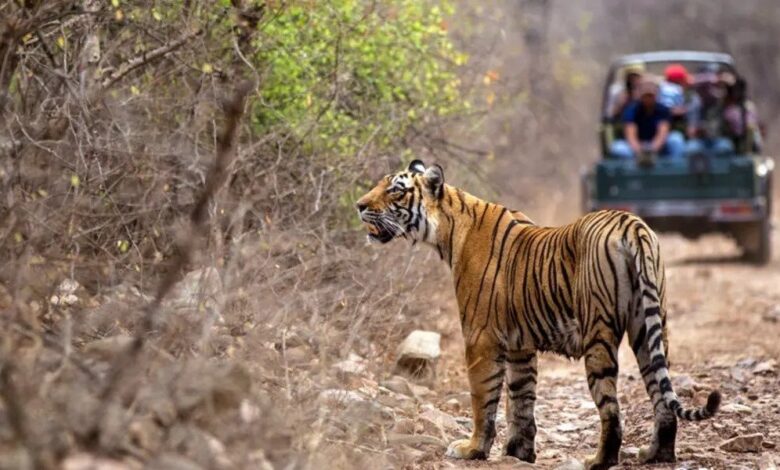Ranthambore National Park’s Wildlife Safari – 5 Reasons To Experience

Tiger Sighting in India is a popular activity for visitors from all over the globe. Around the globe, there are wildlife reserves where fans of the natural world may see regal and fierce tigers all year round. Ranthambore National Park Safari, which covers 1334 square kilometres and is well-known for its Royal Bengal Tigers, is one such national park in India that is worth seeing. Since the reserve is remote, lonely, and encircled by stone and dust, those who like wildlife photography will undoubtedly find it to be an ideal location. There are several wildlife reserves in India, but Ranthambore stands out from the others due to its distinctive location. The site is even more intriguing with its arid, desolate fields, gravel roads, medieval forts, and vibrant atmosphere.
1. Simple to Identify Wild Animals Wandering Unhindered
The exciting part is about to begin! The stunning and graceful Bengal tigers and leopards, who wander freely and enjoy the winter sun, may be seen on a safari ride in the Ranthambore National Park. In addition to a sizable tiger population, other wildlife found in the area includes mugger crocodiles, sambar, chital, nilgai, wild boar, and rufous-tailed hares.
The mountainous landscapes also contain numerous historic temples, such as the Amreswar Mahadev, Kala Gaura, and Chamatkar Jain temples.
Unlike the majority of Indian national parks, Ranthambore has a distinct environment and an abundance of wildlife. In addition to the magnificent tigers, visitors to Ranthambore may enjoy seeing a variety of unique creatures, including leopards, black bucks, sloth bears, Indian flying foxes, jackals, rattles, mongooses, and five-striped palm squirrels. The list of reptiles found in the National Park is extensive and includes cobras, pythons, snub-nosed crocodiles, desert monitor lizards, and more. For those who like animals, visiting this national park is a constant celebration.
Fort Amidst Thick Woods: Due to the attractive fort ruins within the national park, this location is also included as a Heritage site. Throughout the Ranthambore National Park, many real lakes and forts bravely stand inside the wildlife reserve and provide sweeping views of the whole area. The Ranthambore Fort, which is located about 5 miles from the park, is around 700 feet high. The Ranthambore fort is well known for being a member of the “Hill Forts of Rajasthan” UNESCO World Heritage Site.
2. Old Banyan Tree: Ideal Location For Instagram-Desirable Images
Travellers now always have to take images that they can post on Instagram. Do you not concur? The second-largest banyan tree in India is located in the Ranthanthambore National Park, which is a massive tree. It is one of the greatest locations to take Instagram-worthy photos and is close to the Padam Talao Lake.
The Chauhans had previously been in charge of this fort. It was caught in the 13th century by the Delhi Sulnature. It is now a remarkable example of an old-world structure in the midst of the wilderness.
3. The Best Place to See Birds
Wandering about, kicking your feet off the ground, and seeing some of India’s captivating avian inhabitants are some of the things that appeal to me. Bird-watching is something that only the most resilient individuals can do. The quest to identify unique and exquisite bird species never ends. Thus far, around 272 species have been found in the bounded environment. These include a variety of exotic species, including Flamingos, Flycatchers, Grey Hornbills, Nightjars, and many more.
4. The Rich Vegetation and the Age-old Banyan Tree
While animals and birds are wandering through the wildwood, vegetation is essential. Over 300 types of plants and animals make up the diverse flora and wildlife that attract visitors staying in the arid grassland region. The old Banyan tree, with its enormous leathery leaves and foliage spanning a broad area and offering the appropriate shade, is the reason for the popularity of the Ranthambore National Park. In addition, the Ranthambore forest has an abundance of greenery, complementary flora, and unusual, solitary blooms.
5. Visit the Magnificent Ranthambore Fort
The majestic Ranthambore fort is perched on a solitary hill overlooking the vast Tiger Reserve. One of Ranthambore’s main attractions, the fort invites tourists. It is a component of Rajasthan’s Petrography Hill Forts World Heritage Site. Ranthambore is a location that is well worth seeing. An early morning walk and many steps to Ranthambore Fort really contribute to refreshment. The fort’s remnants remain silent witnesses to the past. The Ranthambore Fort is said to have been established around 944 AD by the Nagil Jats, but the Chauhan dynasty’s arrival and establishment of this location as their capital gave rise to the fort’s true prominence. The last ruler of this magnificent fort was Hammir Dev. The main attractions of this fort are the 32-pillar cenotaph and the Ganesh Temple. If you’re fortunate, you may see Tiger on the way to Ranthambore Fort. In actuality, the fort offers an incredible and spectacular perspective of the national park. You must see this old fort if you are planning a trip to Ranthambore.
It is advised to visit Sawai Madhopur’s Rajiv Gandhi Regional Museum of Natural History between the two jungle safari riding times. Located near Village Ram Singhpura Sawai Madhopur, this is the Western Region’s fourth Museum of Natural History. There is no charge to enter the museum. Vertical Panels has stunning images and a wealth of information about nature and its mysteries; each panel is well worth reading. The biodiversity of Rajasthan is the foundation of the museum overall.
Conclusion
Ranthambore is renowned for its temples and historic city. Visitors find Sawai Madhopur to be quite attractive. Madho Singh 1 of Jaipur (1750-1768) established the Old City, known as Sawai Madhopur, and the Mughal Emperor Shah Alam gave the town as a gift. Rolling hills of Vindhayas and Aravallis around it. A welcoming panorama of hummocks awaits every guest. Amreswar Mahadev, Chmatkar Jain Temple, and Kala Gaura Temple are some of the city’s lesser-known attractions. Thousands of tourists are drawn to the local market and its offerings of silver jewellery, lahariya, bandhani, and block-printed fabrics.




